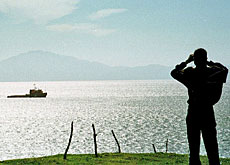Swiss plan tunnel under Strait of Gibraltar

The Swiss Lombardi engineering firm has won the contract to design a railway tunnel between Europe and Africa running under the Strait of Gibraltar.
The company, one of 14 competing for the job, has one year to draw up the plans for one of the most complex projects of its kind ever, on the cards for over a quarter of a century.
A Spanish-Moroccan committee has been considering various options since 1980, not surprising since the difficulties faced by potential builders are a huge challenge. It was only in 2004 that the two countries’ governments decided to go ahead.
A bridge was ruled out because of the depth of the strait. It would be impossible to build supporting pillars in 300 metres of water.
A floating bridge was also not an option because of the number of ships passing through the Gibraltar bottleneck. An underwater tunnel made out of prefabricated elements was considered unfeasible as well as the sea bottom is unstable and currents too strong.
If the project goes ahead, it will be a close cousin of the Eurotunnel that runs under the Channel between France and Britain. Running at depths of up to 600 metres, it will connect Tarifa in Spain to Tangiers in Morocco.
Giovanni Lombardi, the 80-year-old head of the engineering firm, says the planned 40-kilometre tunnel is not the shortest way of connecting the two continents, but simply the best. He adds though that it is just feasible.
Planning for the project will be difficult. Just figuring out the configuration of the seabed will be a challenge.
Ships sent out to prospect its geology had to give up after a week’s work as they were unable to stay in a stable position because of the strong currents washing through the strait.
Public backing
Two publicly owned companies in Spain and Morocco are financing the project. Lombardi reckons it will cost up to €5 billion (SFr7.9 billion) to complete it, but cannot be more precise at this stage.
Preliminary studies should be finished by 2008. A 4.8-metre-wide service tunnel will be built first.
This tube should help the engineers figure how much water might leak into the tunnel. “In the old Gotthard rail tunnel under the Alps, 200 litres of water filter through every second,” said Lombardi.
The pressure on the tunnel will be huge, approximately 500 tons per square metre, so powerful pumps will be needed to avoid it filling up with water.
Another problem is the risk of earthquakes in an active seismological zone. In 1755, an earthquake caused huge damage in the area and killed 50,000 people in the Portuguese capital Lisbon.
Comparatively speaking, building the Eurotunnel was much easier reckons Lombardi, who also worked on the Channel project. “Eurotunnel didn’t go as deep, water pressure was lower and the rock was more solid,” he added.
The Gibraltar project is Lombardi’s biggest challenge so far, but he is confident he can overcome all the obstacles in his path. “If you aren’t optimistic, you never achieve anything,” he said.
swissinfo with agencies
Born in 1926 in Lugano, Lombardi is one of Switzerland’s best known civil engineers.
His most famous project has been the the construction of the Gotthard road tunnel through the Alps, the second-longest in the world (24.6 kilometres) and opened in 1980.
His firm employs 85 people and is currently focusing on the new base railway tunnel under the Gotthard, over 57 kilometers long.

In compliance with the JTI standards
More: SWI swissinfo.ch certified by the Journalism Trust Initiative










You can find an overview of ongoing debates with our journalists here . Please join us!
If you want to start a conversation about a topic raised in this article or want to report factual errors, email us at english@swissinfo.ch.